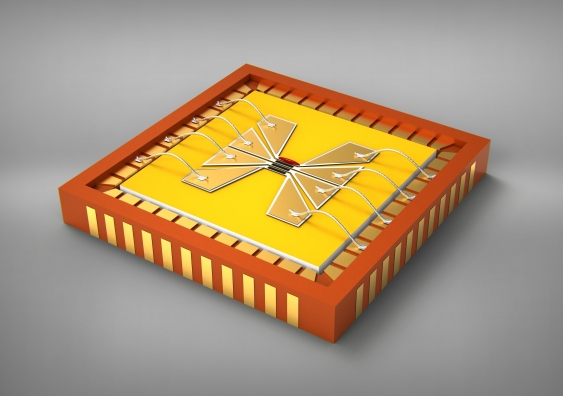
R&D Work Suggests Metasurfaces Could Supplant LCD; Boosting Resolution, Halving Power Needs
February 23, 2023 by Dave Haynes
University researchers in the UK and Australia are collaborating on the development of a new kind of engineered material that would be much thinner than LCD technology, boost resolution 10-fold, and use half the power.
Researchers at Nottingham Trent University in the UK, the Australian National University (ANU), and the University of New South Wales (UNSW) Canberra have been working on what is called metasurface technology. Their findings are published today in Light: Science & Applications.
The tech is described as a “type of engineered material that can control the propagation of electromagnetic waves, including light, in ways that are not possible with traditional materials. It is made up of a planar array of sub-wavelength-sized structures, which can be designed to manipulate the phase, amplitude, polarization, and direction of the electromagnetic waves that interact with them.”
“Metasurfaces can be used to create flat optical components, such as lenses, beam deflectors, and polarizers, that are much thinner and lighter than traditional optics. They can also be used to manipulate the color, intensity, and direction of light in new and exciting ways, making them useful for a wide range of applications in fields such as telecommunications, imaging, and sensing.”
Here’s more detail from the University of New South Wales (UNSW) Canberra:
Metasurfaces are 100-times thinner than liquid crystal cells, offer a 10-fold greater resolution and could consume less energy.
Today’s screen display market offers a large range of choices, each with its pros and cons. However, factors including production costs, lifespan and energy consumption have kept LCD technology the most dominant and popular technology for screens such as TV sets and monitors.
Liquid crystal cells are responsible for switching the transmitted light on and off and are constantly lit by a backlight, with polarising filters in the front and behind the pixels, forming a cross-polarised setup. They determine the dimension of pixels – the resolution – and play a significant role in managing the device’s power consumption.
The newly-engineered metasurface cells – which have tunability and extraordinary light scattering properties – would replace the liquid crystal layer and would not require the polarisers, which are responsible for half of wasted light intensity and energy use in displays.
“Our pixels are made of silicon, which offers a long life span in contrast with organic materials required for other existing alternatives. Moreover, silicon is widely available, CMOS* compatible with mature technology, and cheap to produce,” said Professor Andrey Miroshnichenko, a lead researcher in the Nanophotonics team at UNSW Canberra.
“We hope this development could generate a frontier technology in new flat screen displays, which had a global market value of about $117 billion in 2020.”
Building a large-scale prototype
The next phase of research will be building a large-scale prototype and generating images, which is hoped to be achieved within the next five years. Once the prototype has successfully generated high-definition images it is expected the technology will be integrated into flat screens and available to the public within the next 10 years.
Professor Dragomir Neshev, Director of the ARC Centre for Excellence in Transformative Meta-Optical Systems (TMOS) and ANU Professor in Physics, said the capability of conventional flat screen displays has reached its peak and is unlikely to significantly improve in the future due to multiple limitations.
“Today there is a quest for fully solid-state flat display technology with a high-resolution and fast refresh rate. We have designed and developed metasurface pixels that can be ideal for the next-generation display,” Professor Neshev said.
“Unlike liquid crystals, our pixels do not require polarised lights for functioning, which will halve screens’ energy consumption.”
Khosro Zangeneh Kamali, a PhD scholar at ANU and the first author of the study, said metasurfaces are proven to exhibit extraordinary optical behaviour.
“Inventing an effective way to control metasurfaces is still a subject of heavy research. We have proposed electrically tunable silicon nanostructures, which is a versatile platform for programmable metasurfaces.”
Dr Lei Xu, a team member from Nottingham Trent University, said: “There is significant room for further improvements by employing artificial intelligence and machine learning techniques to design and realise even smaller, thinner and more efficient metasurface displays.”
“We have paved the way to break a technology barrier by replacing the liquid crystal layer in current displays with a metasurface, enabling us to make affordable flat screens liquid crystal-free,” said lead researcher Mohsen Rahmani, Professor of Engineering at Nottingham Trent University’s School of Science and Technology and a Royal Society Wolfson Fellow.
“The most important metrics of flat panel displays are pixel size and resolution, weight and power consumption. We have addressed each of these with our meta-display concept.
“Most importantly, our new technology can lead to a huge reduction of energy consumption – this is excellent news given the number of monitors and TV sets being used in households and businesses every single day. We believe it is time for LCD and LED displays to be phased out in the same way as former cathode ray tube (CRT) TVs over the past 10 to 20 years.”
The five-to-10 year timeline for when this technology might get beyond labs and into production lines means it will be emerging just as, or possibility after, mass production of microLED comes online – also offering better resolution and brightness, plus the ability to embed in different materials like glass and, possibly, ceramics.



Leave a comment